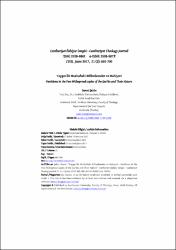| dc.contributor.author | Şahin, Davut | |
| dc.date.accessioned | 2021-01-14T18:19:24Z | |
| dc.date.available | 2021-01-14T18:19:24Z | |
| dc.date.issued | 2017 | |
| dc.identifier.issn | 2528-9861 | |
| dc.identifier.issn | 2528-987X | |
| dc.identifier.uri | https://app.trdizin.gov.tr/makale/TWpJMU5EazVPUT09 | |
| dc.identifier.uri | https://hdl.handle.net/20.500.12587/13640 | |
| dc.description.abstract | Çalışma yaygın iki mushafın bölümlemeleri hakkındadır. Bu mushaflardan biri Türkiye'de basılmakta, Diyanet İşleri Başkanlığı, Mushafları İnceleme ve Kıraat Kurulu'nun denetiminden geçmektedir. Diğeri ilmî bir heyet tarafından yayına hazırlanmış olup, Suudi Arabistan İslami İşler, Vakıflar, Davet ve İrşat Bakanlığı tarafından basılmaktadır. Her iki mushaf başta basım yerleri olmak üzere birçok ülkede yaygındır. Çalışmada söz konusu mushaflardaki bölümlemeler dayanakları ve işlevleri açısından karşılaştırmalı olarak ele alınmaktadır. Bu bağlamda önce söz konusu bölümlemelerin Hz. Peygamber'in, sahabenin söz ve uygulamaları ile ilgisi kurulmaktadır. Sonra bu mushaflardaki aynı ve farklı bölümlemeler, aynı ismi taşıyan bölümlemelerin farklılaşan yönleri incelenmektedir. Ayrıca mevcut bölümlemelerin işlevlerine değinilmektedir. Türkiye'de basılan mushafta yer alan "rükû? alameti" araştırılmaktadır. Bu bölümlemeye "alameti mevdu?" isminin verilmesi önerilmektedir. Uygulamaları Hz. Peygamber döneminde olsa da bölümlemelerdeki farklılıklar, mevcut bölümlemelerin ictihâdî olduğunu göstermektedir | en_US |
| dc.description.abstract | The study is mainly about the partitions of the two widespread copies of the Qur'an known as mushafs. One of these partitions is published in Turkey under the supervision of the Presidency of Religious Affairs, and the Board of Inspection and Recitation of the Qur'an. The second one is published by an Islamic delegation and by the Ministry of Islamic Affairs, Foundations, Invitation and Guidance of Saudi Arabia. Both the mushafs are widely used in many countries, especially in terms of the places where they are printed. In the study, the partitions in the mushafs are discussed in a comparative manner in terms of their bases and their functions. In this context, first of all, the mentioned partitions are linked together with the words and practices of The Prophet and his companions. Then the same and different partitions in these mushafs and, different aspects of the same partitions are examined. The functions of existing departments are also mentioned. The "symbol of bowing (Ruku?)" on this mushaf published in Turkey is examined. It is recommended that this section should be named as "the symbol of mawdu?." Even the practices belong to the period of the Prophet, the differences in the partitions show that the existing divisions are based on opinions or judicial judgments (ijtihadi) | en_US |
| dc.language.iso | tur | en_US |
| dc.rights | info:eu-repo/semantics/openAccess | en_US |
| dc.subject | Din Bilimi | en_US |
| dc.title | Yaygın İki Mushaftaki Bölümlemeler ve Mahiyeti | en_US |
| dc.title.alternative | Partitions in the Two Widespread copies of the Qur'an and Their Nature | en_US |
| dc.type | article | en_US |
| dc.identifier.volume | 21 | en_US |
| dc.identifier.issue | 1 | en_US |
| dc.identifier.startpage | 665 | en_US |
| dc.identifier.endpage | 700 | en_US |
| dc.relation.journal | Cumhuriyet İlahiyat Dergisi | en_US |
| dc.relation.publicationcategory | Makale - Ulusal Hakemli Dergi - Kurum Öğretim Elemanı | en_US |
















